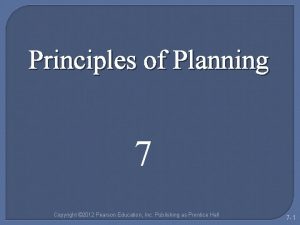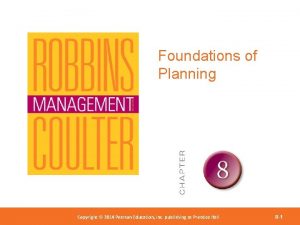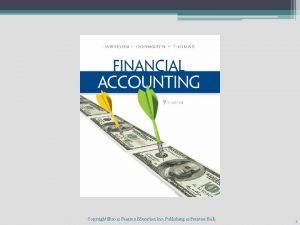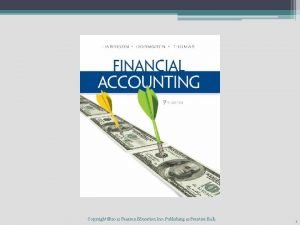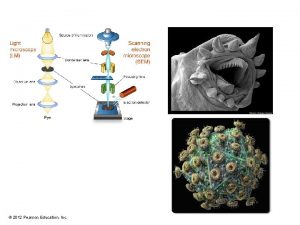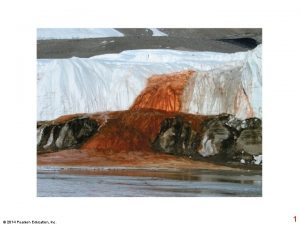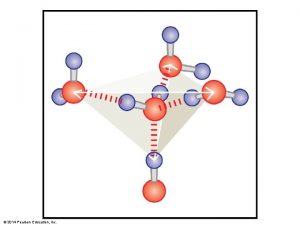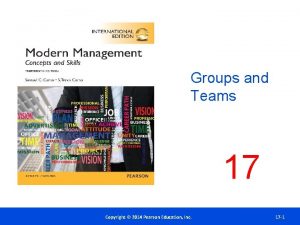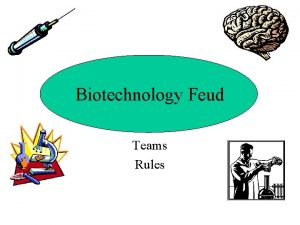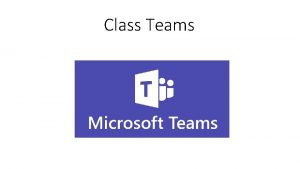Managing Teams Copyright 2012 Pearson Education Copyright 2014
























- Slides: 24

Managing Teams Copyright 2012 Pearson Education, Copyright © 2014 Pearson©Education, Inc. publishing as Prentice Hall Inc. Publishing as Prentice Hall 14 -1

What Is a Group? • Group - two or more interacting and interdependent individuals who come together to achieve specific goals. – Formal groups • Work groups defined by the organization’s structure that have designated work assignments and tasks – Informal groups • Groups that are independently formed to meet the social needs of their members Copyright 2012 Pearson Education, Copyright © 2014 Pearson©Education, Inc. publishing as Prentice Hall Inc. Publishing as Prentice Hall 14 -2

Examples of Formal Work Groups Copyright 2012 Pearson Education, Copyright © 2014 Pearson©Education, Inc. publishing as Prentice Hall Inc. Publishing as Prentice Hall 14 -3

Stages of Group Development • Forming stage - the first stage of group development in which people join the group and then define the group’s purpose, structure, and leadership • Storming stage - the second stage of group development, characterized by intragroup conflict • Norming stage - the third stage of group development, characterized by close relationships and cohesiveness. Copyright 2012 Pearson Education, Copyright © 2014 Pearson©Education, Inc. publishing as Prentice Hall Inc. Publishing as Prentice Hall 14 -4

Stages of Group Development (cont. ) • Performing stage - the fourth stage of group development when the group is fully functional and works on group task. • Adjourning - the final stage of group development for temporary groups during which group members are concerned with wrapping up activities rather than task performance. Copyright 2012 Pearson Education, Copyright © 2014 Pearson©Education, Inc. publishing as Prentice Hall Inc. Publishing as Prentice Hall 14 -5

Stages of Group Development Copyright 2012 Pearson Education, Copyright © 2014 Pearson©Education, Inc. publishing as Prentice Hall Inc. Publishing as Prentice Hall 14 -6

Work Group Performance and Satisfaction • Why are some groups more successful than others? – The abilities of the group’s members – The size of the group – The level of conflict – The internal pressures on members to conform to the group’s norms Copyright 2012 Pearson Education, Copyright © 2014 Pearson©Education, Inc. publishing as Prentice Hall Inc. Publishing as Prentice Hall 14 -7

External Conditions Imposed on the Group • Work groups are affected by the external conditions imposed on it: – – – – The organization’s strategy Authority relationships Formal rules and regulations Availability of resources Employee selection criteria The performance management system and culture The general physical layout of the group’s work space Copyright 2012 Pearson Education, Copyright © 2014 Pearson©Education, Inc. publishing as Prentice Hall Inc. Publishing as Prentice Hall 14 -8

Group Member Resources • A group’s performance potential depends to a large extent on the resources each individual brings to the group. These include: – Knowledge – Abilities – Skills – Personality traits Copyright 2012 Pearson Education, Copyright © 2014 Pearson©Education, Inc. publishing as Prentice Hall Inc. Publishing as Prentice Hall 14 -9

Group Structure • Role - behavior patterns expected of someone occupying a given position in a social unit. • Norms - standards or expectations that are accepted and shared by a group’s members. • Groupthink - when a group exerts extensive pressure on an individual to align his or her opinion with that of others. Copyright 2012 Pearson Education, Copyright © 2014 Pearson©Education, Inc. publishing as Prentice Hall Inc. Publishing as Prentice Hall 14 -10

Group Structure (cont. ) • Status - a prestige grading, position, or rank within a group. • Social loafing - the tendency for individuals to expend less effort when working collectively than when working individually. • Group cohesiveness - the degree to which group members are attracted to one another and share the group’s goals. Copyright 2012 Pearson Education, Copyright © 2014 Pearson©Education, Inc. publishing as Prentice Hall Inc. Publishing as Prentice Hall 14 -11

Group Structure (cont. ) • Group Size – Small groups are faster than larger ones at completing tasks – Large groups consistently get better problem solving results than smaller ones – Amazon founder and CEO Jeff Bezos uses a “two-pizza” philosophy; that is, a team should be small enough that it can be fed with two pizzas. Copyright 2012 Pearson Education, Copyright © 2014 Pearson©Education, Inc. publishing as Prentice Hall Inc. Publishing as Prentice Hall 14 -12

Group Structure (cont. ) • Group Processes - processes that go on within a work group determines group performance and satisfaction. These include: – Communication – Decision making – Conflict management Copyright 2012 Pearson Education, Copyright © 2014 Pearson©Education, Inc. publishing as Prentice Hall Inc. Publishing as Prentice Hall 14 -13

Group Structure (cont. ) • Group Decision Making - most organizations use groups to make decisions. • Advantages of group decision making – More complete information and knowledge – A diversity of experience and perspectives – Increased acceptance of a solution • Disadvantages of group decision making – Groups almost always take more time n – Dominant and vocal minority can influence the decision – Groupthink Copyright 2012 Pearson Education, Copyright © 2014 Pearson©Education, Inc. publishing as Prentice Hall Inc. Publishing as Prentice Hall 14 -14

Conflict Management • Conflict - perceived incompatible differences that result in interference or opposition. • Traditional view of conflict - the view that all conflict is bad and must be avoided. • Human relations view of conflict - the view that conflict is a natural and inevitable outcome in any group Copyright 2012 Pearson Education, Copyright © 2014 Pearson©Education, Inc. publishing as Prentice Hall Inc. Publishing as Prentice Hall 14 -15

Conflict Management (cont. ) • Interactionist view of conflict - the view that some conflict is necessary for a group to perform effectively. • Functional conflicts - conflicts that support a group’s goals and improve its performance. • Dysfunctional conflicts - conflicts that prevent a group from achieving its goals. Copyright 2012 Pearson Education, Copyright © 2014 Pearson©Education, Inc. publishing as Prentice Hall Inc. Publishing as Prentice Hall 14 -16

Conflict Management (cont. ) • Task conflict - conflicts over content and goals of the work. • Relationship conflict - conflict based on interpersonal relationships. • Process conflict - conflict over how work gets done. Copyright 2012 Pearson Education, Copyright © 2014 Pearson©Education, Inc. publishing as Prentice Hall Inc. Publishing as Prentice Hall 14 -17

Turning Groups into Effective Teams • Work teams - groups whose members work intensely on a specific, common goal using their positive synergy, individual and mutual accountability, and complementary skills Copyright 2012 Pearson Education, Copyright © 2014 Pearson©Education, Inc. publishing as Prentice Hall Inc. Publishing as Prentice Hall 14 -18

Groups Versus Teams Copyright 2012 Pearson Education, Copyright © 2014 Pearson©Education, Inc. publishing as Prentice Hall Inc. Publishing as Prentice Hall 14 -19

Types of Work Teams • Problem-solving team - a team from the same department or functional area that’s involved in efforts to improve work activities or to solve specific problems. • Self-managed work team - a type of work team that operates without a manager and is responsible for a complete work process or segment. Copyright 2012 Pearson Education, Copyright © 2014 Pearson©Education, Inc. publishing as Prentice Hall Inc. Publishing as Prentice Hall 14 -20

Types of Work Teams (cont. ) • Cross-functional team - a work team composed of individuals from various functional specialties. • Virtual team - a type of work team that uses technology to link physically dispersed members in order to achieve a common goal. Copyright 2012 Pearson Education, Copyright © 2014 Pearson©Education, Inc. publishing as Prentice Hall Inc. Publishing as Prentice Hall 14 -21

Creating Effective Work Teams • Clear Goals - high-performance teams have a clear understanding of the goal to be achieved • Relevant Skills – team members have the necessary technical and interpersonal skills • Mutual Trust - effective teams are characterized by high mutual trust among members • Unified Commitment – members are dedicated to team goals Copyright 2012 Pearson Education, Copyright © 2014 Pearson©Education, Inc. publishing as Prentice Hall Inc. Publishing as Prentice Hall 14 -22

Creating Effective Work Teams (cont. ) • Good Communication – messages are clearly understood • Negotiating Skills - members need are able to confront and reconcile differences • Appropriate Leadership – leaders motivate a team to follow through difficult situations • Internal and External Support – proper training, incentives, and resources Copyright 2012 Pearson Education, Copyright © 2014 Pearson©Education, Inc. publishing as Prentice Hall Inc. Publishing as Prentice Hall 14 -23

Characteristics of Effective Teams Copyright 2012 Pearson Education, Copyright © 2014 Pearson©Education, Inc. publishing as Prentice Hall Inc. Publishing as Prentice Hall 14 -24
 Copyright 2014 pearson education inc
Copyright 2014 pearson education inc Pearson education inc. 2012
Pearson education inc. 2012 2012 pearson education inc
2012 pearson education inc 2012 pearson education inc
2012 pearson education inc 2012 pearson education inc
2012 pearson education inc Chapter 1 an introduction to anatomy and physiology
Chapter 1 an introduction to anatomy and physiology Pearson education inc. 2012
Pearson education inc. 2012 Pearson education inc. 2012
Pearson education inc. 2012 2012 pearson education inc anatomy and physiology
2012 pearson education inc anatomy and physiology 2012 pearson education inc
2012 pearson education inc 2012 pearson education inc
2012 pearson education inc 2012 pearson education inc
2012 pearson education inc 2012 pearson education inc
2012 pearson education inc Pearson education 2012
Pearson education 2012 Pearson education inc. 2012
Pearson education inc. 2012 2012 pearson education inc
2012 pearson education inc 2012 pearson education inc
2012 pearson education inc 2012 pearson education inc
2012 pearson education inc Pearson 2012
Pearson 2012 2012 pearson education inc
2012 pearson education inc 2014 pearson education inc
2014 pearson education inc 2014 pearson education inc
2014 pearson education inc 2014 pearson education inc
2014 pearson education inc 2014 pearson education inc
2014 pearson education inc 2014 pearson education inc
2014 pearson education inc







